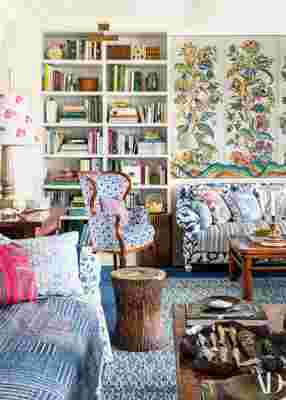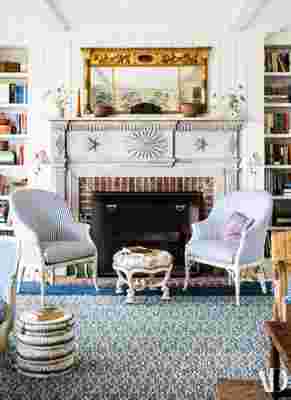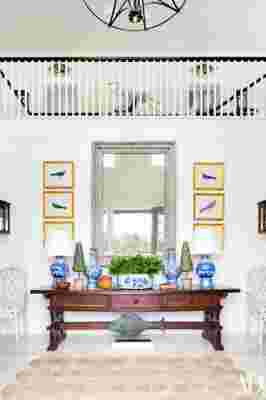On the hook-shaped Massachusetts isle of Nantucket, at the edge of a wind-ruffled salt marsh that fades away into the rolling Atlantic, sits a house of flowers. Not an address literally embowered by blossoms, mind you (the acreage is still a work in progress), but a smartly shingled affair with rooms that bring to mind a few high-summer herbaceous borders turned outside in.
Colorful buds bloom on finely pleated lamp shades and atop a chubby little Napoléon III rope-twist stool. Flowering vines unfurl across the dining room’s crisp box-pleated slipcovers and the living room’s plump skirted sofas. Florets of undetermined origin sprout on walls, ramble up curtains, coil around cushions, effloresce on quilts, and unfold on a boldly stenciled floor. In a guest bedroom, a screen is inset with images of shaggy pink and red chrysanthemums, the polychrome prints taken from the 1890s One Hundred Chrysanthemums series by Japanese master Hasegawa Keika.
Location matters—it matters a lot.
As in any fertile demesne, there are butterflies (printed), birds (carved, gilded, painted), and even a frog (sculpted). Given Nantucket’s seafaring industries, there is a fishmonger’s worth of artful shellfish and crustaceans, such as the 19th-century Palissy-ware variety that scramble up the powder-room walls like a catch on the loose. Then there are the baskets—dozens of them, it seems—exquisitely woven rattan and cane receptacles that have been an island tradition since the 1830s, many of them fashioned by Susan Chase Ottison, scion of a generations-old hand-weaving dynasty.
“Location matters—it matters a lot” when it comes to decorating, the house’s Southern-belle occupant says in a bourbon-and-branch drawl. As for the vintage residence she purchased a few years ago, it was precisely what she, a Nantucket regular since a newlywed trip took her there in the late 1960s, had always desired. “I walked straight through the front door, out into the yard, looked at that marsh, and told my son, ‘This house is perfect.’ ” One exquisitely timed pause later, she deadpans, “Then I knocked it down.”

Painted panels by Bob Christian hang in the living room.

A pair of 19th-century English armchairs in a GP & J Baker stripe cozy up to the living-room fireplace. Antique neoclassical mirror over mantel; antique French rope stool; custom rug by Markham Roberts.
AD100 interior designer Markham Roberts explains, “She lived in it for a summer and realized it wasn’t perfect at all.” So his client proceeded to build something authentic , still shingled in the island vernacular, but with two scoops of Southern soul—plus dead-level floors and impressive soundproofing, which the earlier house signally lacked.
“A book about Furlow was the inspiration,” she says. That would be Georgia aesthete Furlow Gatewood and One Man’s Folly, a 2014 celebration of rural charm. His signature wood walls, puzzled together in ways that recall homespun farmhouses and dependencies, struck the owner and Roberts as eminently desirable as the new house got under way. Ditto Gatewood’s chalky painted finishes (decorative artists Bob Christian and Harry Lendrum channeled them for the Nantucket project), which look “as if they had been there forever,” she recalls.

“I wanted old, I wanted detail, I wanted this place to feel like my grandmother’s house, which had beadboard everywhere,” she continues. “Well, had I known what it was going to cost”—cue a barely imperceptible arch of one eyebrow—“I might not have done it.”
To fill the new yet old-fashioned envelope, she delivered decades of belongings into her decorator’s eager hands. From a romantic Chinese Export painting of sailing ships that references Massachusetts’s seafaring history (“I took it from my son because he didn’t like the frame—oh, deliver me, deliver me”) to round trivets (“I have a million of them”), her lifetime of oddments now commingle with fetching auction finds as well as captivating punctuations, among them the entrance hall’s Julia Condon mandala paintings, which she snapped up from the astute art-and-antiques dealer James Sansum, Roberts’s companion and office mate.
“Better than owning a fashion-victim purse—who buys all that whoop-de-do?” the client tartly states, observing that her own handbags tend to be serviceable “because I’m boring.”
Spread across the sitting-room floor is a leafy blue-and-green carpet that the late, great British tastemaker John Fowler conjured up in the 1960s for Bunny Mellon’s Manhattan dining room. In a guest bath, plants are tucked into a rafraîchissoir, one of those French tables that have integral metal buckets for keeping bottles of wine cool. Painted-wood shorebirds by Nantucket legend Pat Gardner preen on plainspoken brackets that have been grouped, here and there, to form flocks.
Roberts did more than just arrange and augment, of course. An old-school decorator at heart, despite his youthful demeanor, he trimmed, mixed, matched, commissioned, and, frankly, enjoyed himself. He designed dining chairs, colorful quilts, even mitered cushions in the living room. Striped red-and-white fabric was cut up and reassembled into soft paneling for the dining room, where Christian painted giant daisylike quatrefoils on the floor, a kicky combo that everyone agrees is a terrific success. “Not every client’s going to indulge your creativity,” Roberts admits. To which this particular patron instantly responds, “Honey, that’s why everything’s so vanilla.”
